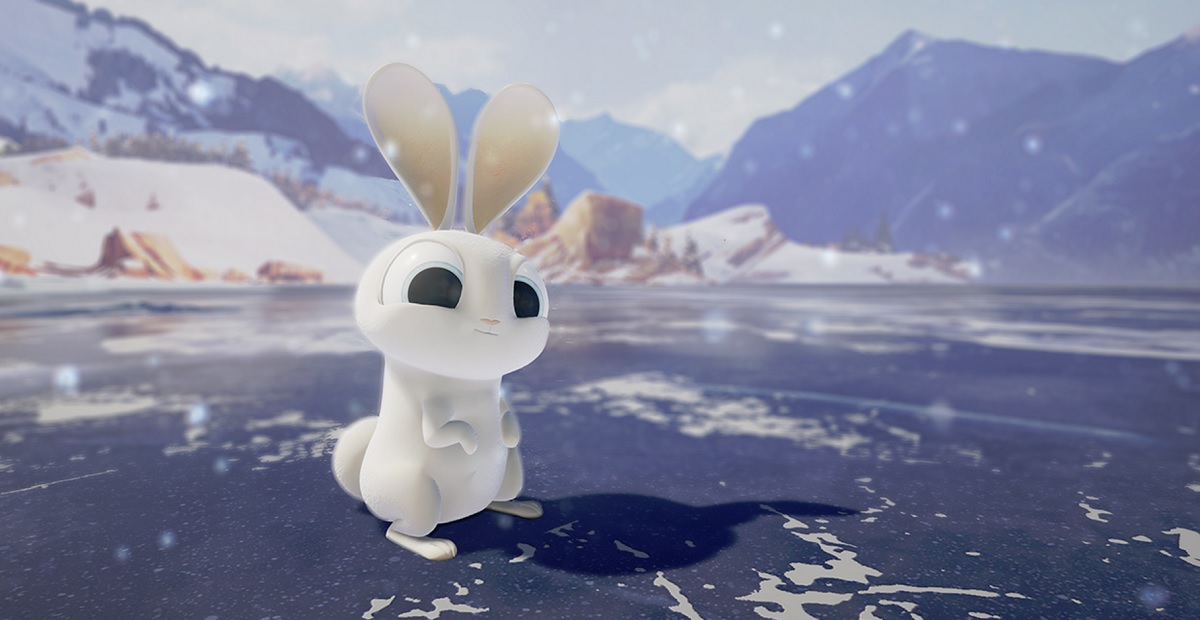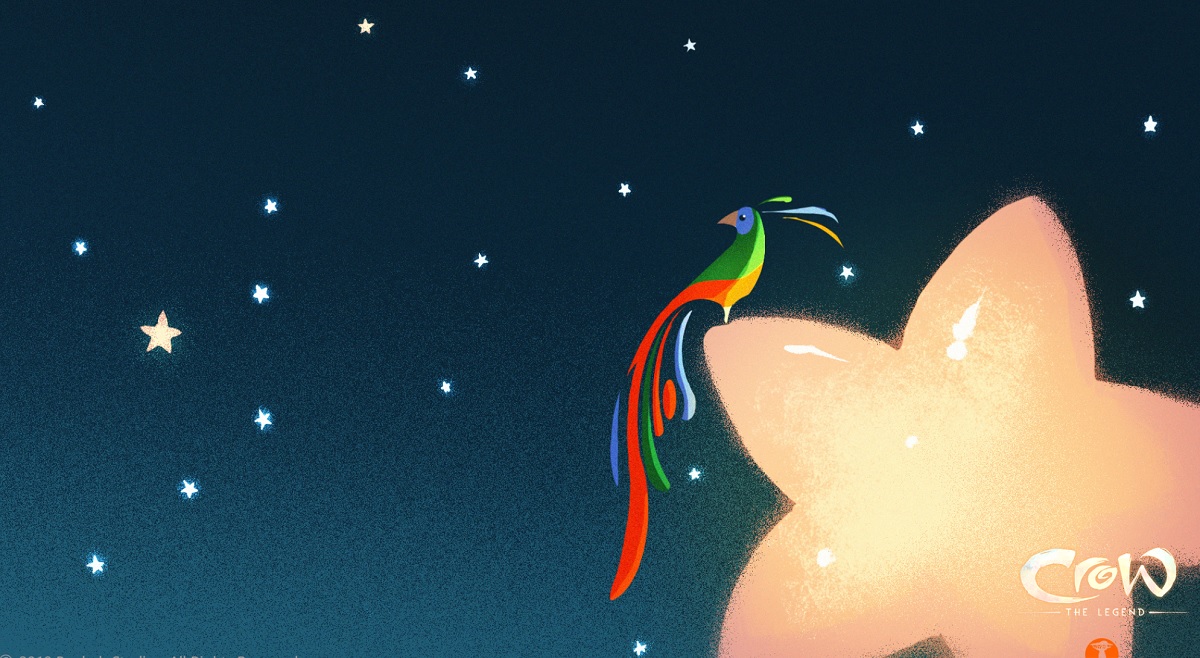Crow: The Legend debuted last week as a new animated film for both 2D viewing on YouTube and Facebook, as well as an interactive virtual reality experience. The creator, Baobab Studios, released the film for free as part of an effort to pioneer entertainment in the new medium.
In part because the film tells a meaningful story about a Native American origin legend, Baobab leaders Maureen Fan (CEO) and Eric Darnell (chief creative officer and creator of the Madagascar animated film series) were able to cast entertainers John Legend, Oprah Winfrey, and Constance Wu.
The interactive VR experience can last about 25 minutes, and it enables viewers to interact with the world — like using their hand controllers to touch stars and make music happen. Darnell and Fan hope that the VR users will linger longer in the environment of the world they have created.
To bring the story of Crow: The Legend to life, Baobab partnered with Native Americans in Philanthropy (NAP). Sarah Eagle Heart, CEO of NAP, voices the character of Luna.
Coming on the heels of the back-to-back Emmy Award-winning releases Asteroids! and Invasion!, Crow: The Legend is Baobab Studios’ most ambitious project to date. It took 15 people about a year to create, but Fan said it is an important story about indigenous peoples that was overlooked or stifled in the past.
Here’s an edited transcript of our interview.

Above: Maureen Fan is CEO of Baobab Studios.
VentureBeat: It looks like you guys hit a big milestone here, finishing the project.
Maureen Fan: It’s a big deal. This is the team’s most ambitious project to date. We want to make sure the launch goes as smoothly as possible. We’re super excited.
VentureBeat: How long did you work on this one? How do you think it’s turned out?
Fan: We had a team of about 15 people, and we worked on it for about a year. I’m biased, of course, but I think it’s wonderful. We needed to make sure we did the original Native American story justice. We always knew that it was based on a Native American legend, but we learned, through the creation of this piece — we brought on two cultural advisors. Sarah Eagle Heart is the CEO of Native Americans in Philanthropy, our executive producers. Randy Edmonds is an 84-year-old Kiowa-Caddo tribal elder. He founded the National Indian Urban Council and was involved in the Oklahoma relocation.
When we were creating this, they taught us that many Native American youth were forced into re-education camps and told that they were not allowed to tell stories like this. They were considered pagan. Many of their stories were wiped from history, so to them, it was a big deal that we’re sharing this story. Our piece is one of the only, if not the first, animated pieces that shows an indigenous world view where they’re telling the story authentically rather than just us doing it. We wanted to make sure it was done well. It was an honor that they trusted us to do it, but we needed to make sure it was as true and authentic to Native American culture as possible.
I think we did a good job. It’s our most ambitious project yet because we created both a 2D and a VR version. The VR version comes in at around 25 minutes. It’s obviously pretty long. It has many different characters and environments, which is logistically ambitious for anyone in animation. We wanted to figure out what the role of the viewer is. Eric can talk more about the interactivity and the things we were experimenting with.

Above: Eric Darnell, creator of the Madagascar series, is chief creative officer at Baobab Studios.
Eric Darnell: Our first piece, Invasion!, we did before hand controllers were available. All we could do as far as interactivity was giving the viewer that white bunny that sort of hung out beneath their head and changed shape a bit when the viewer moved around. We really leaned into eye contact between the viewer and that bunny character that became your friend in the story — and eye contact between the viewer and the aliens as well.
With Asteroids!, we had hand controllers. We could lean into the interactivity, making the viewer able to interact with things in the environment. That was our first big education in the things you can do with that kind of agency. It becomes complicated really quick. If you look at the hand controllers, they have lots of triggers and buttons and knobs. There’s a lot of potential in terms of how you can use them.
When we got to Crow, we decided to try to make something that didn’t require the viewer to build up any experiential knowledge of the hand controllers. Instead, all they needed to do was wave their arms, like a magician, or like the spirit they play in the story. With just a gesture — a wave of your hand — as the spirit, you can make the grasses grow and the flowers bloom. The sun comes out. The snow falls. When you follow the hero on his journey to bring warmth to the animals, you’re flying through outer space.
You can wave your arms like a musical conductor and play the music of the universe. Depending on what you do, the music manifests itself differently. It’s up to the viewer to be part of this additive, interactive process with their arms to conduct this music. It sounds different depending on the individual viewer and how they choose to interact. It became a much more natural, organic way of allowing our viewers to interact with the environment. It turned out to be really successful.

Above: The hero of Invasion!
VentureBeat: Back to some basics, how do you guys make money on this one?
Fan: We’re offering it for free on purpose because we want to make sure as many people as possible experience the Native American legend as possible. That was important to the cast. We aren’t very rich, as you know. We’re a startup. To have this amazing cast — we’re pinching ourselves all the time. But for them, one of the main reasons they wanted to be a part of this piece was because of the themes of diversity and sacrifice — and because it’s a story of an underrepresented community. It was important to us and them to make sure that as many people could experience it as possible. Making it free allows that.
VentureBeat: Did the split between doing it [in] 2D and doing it in VR give you a chance to make money getting it on TV, something like that?
Fan: There are always changes for us to make money, but for this one in particular, we made a conscious choice not to. You can imagine that for Baobab, we want our characters and universes and stories to live beyond any one particular medium. We consider ourselves an immersive animation studio. Anything that’s considered immersive is what we do, which is why we’ve also experimented with location-based entertainment. We premiered Jack, a version of Jack and the Beanstalk, at the TriBeCa film festival with a new director, Mathias Chelebourg. We’re doing AR, VR, LBE, and you can imagine other things as well.
VentureBeat: Asteroids! is that the one you were planning to possibly expand into a feature film?
Fan: Asteroids! and Invasion! are part of the same universe. They’re the same characters, Mac and Cheese. That’s the franchise and set of characters we announced a film deal around.
VentureBeat: Is there any similar deal possible with this one?
Fan: I can’t talk about anything now. But at Baobab, we’re always looking to expand our stories across many different mediums.
VentureBeat: Is that possibly why people have confidence in you guys? You can make a short, but you could also potentially make that into something a lot more valuable by building it into an animated feature.
Fan: I’m not sure, when you say “people,” how “people” have confidence in us. I can say that the reason why the cast that has come on and decided to work with us — one, it’s because of the themes, specifically, that they were attracted to in this project. But also, if you think about Eric, Eric co-directed all four Madagascar films, as well as Antz. He’s worked with the likes of Sharon Stone, Woody Allen, Ben Stiller, Alec Baldwin. Being talent in the hands of an experienced director really helps.
Of course, Eric creates stories that have been hugely successful, both critically and commercially. He’s created franchises, not just one-off hits. These are things that give our company legs. We still think content is king. What’s going to drive the medium to become mass market is ultimately content that’s universally appealing. That’s going to bring audiences into these headsets. That’s what Invasion! did, which is why it was a top VR experience on the download charts, and we hope Crow will do that as well.

Above: You can interact with the stars in the VR version of Crow: The Legend.
VentureBeat: Does some financing also come from Oculus?
Fan: Oculus is indeed our launch partner. We can’t go into detail about everything that entails, but you can expect, as with all Baobab projects, that it will be available on all headsets eventually, but Oculus is our launch partner.
VentureBeat: With this project, were you aiming toward this length of story for a particular reason?
Darnell: We weren’t focusing on a length. But this is the length that the story needed to be told correctly. That’s one of the reasons why it was such an ambitious project. We wouldn’t have chosen to take it on at the very beginning of our company. We felt like we had enough work under our belts and enough knowledge about how we could move VR forward with this piece, as well as how we could tell this piece as best we could. We thought it was time.
There’s not a lot of projects out there that run this length, especially animated projects. In fact, I don’t know if there are any. It’s almost one-third of a feature film, one-fourth of a feature film. It’s a lot of work for a small company with 15 full-time employees. We felt like we were ready to do it.
Because we paralleled the process with VR and 2D at the same time, we could leverage the work we were doing in each of the distinct mediums, so it didn’t necessarily take twice as long to create this. We created one set of characters we could use in both versions and so on. There are some differences because the VR piece has to run in real time in Unity. All the animation, all the characters, all the sound that you see in here is created on the fly.
Obviously, in the film version, we could create all the imagery ahead of time. We still use Unity to do that. But that just allowed us, in the 2D piece, to leverage some of the things we’re familiar with in cinema, like depth of field and more dense lighting, that kind of thing.
Fan: That last point is pretty important, regarding the storybook feel. We did have to develop a lot of proprietary technology to get the storybook feeling you see in Crow. There’s a reason why, in the early days of VR — and in the early days of computer graphics, for that matter — people mostly created hard metallic objects, things like toys. Designing hard objects, it’s much easier to create that when you’re limited in your rendering cycles.
But Eric, being our visionary creative, wanted us to create that storybook feel. We wanted it to be so inviting that you’d want to go in and touch the animals. You’d want to feel the grass, feel the flora and fauna around you. We had to create the kind of effects where that looks fuzzy and soft wherever you go. This is normally easy to do in 2D because you’re looking at a screen. You can just cheat it and make the edges fuzzy. But in VR and you can walk around everything. We have to maintain that edge wherever you go.
We had to develop a lot of our own technology to create that. We were able to do that in Unity, and they were super helpful. But we also had to create a lot of proprietary technology to be able to create the 2D pipeline and the VR pipeline together, as well as different lighting methods. In computer animation, you can have multiple lights in one scene, but in a game engine, you can usually have only one light. We had to develop a system that allowed us to have the kind of theatrical lighting setup we used, as well as, of course, the technology that allowed us to have this high-quality animation running in a real-time game engine.

Above: Crow: The Legend is a Native American fable.
VentureBeat: I haven’t seen a lot of the interactivity yet because I’ve only seen the 2D version. But does the VR version allow you to stop and play around a lot more, as opposed to just watching the story?
Fan: Right. In the VR version, as soon as you start off, you’re given these hands. You actually make the seasons change. You make it spring. You make it winter. When you move your hands, you can throw snow around. It’s super fun. You can think of it like a snow globe. People like to wave their arms above them.
We learned a lot about interactivity in this piece, especially in the space sequence. In the 2D version, the space sequence is super short, but in VR, it’s actually quite lengthy because that’s the part that audiences really loved. You fly through several areas in space, and based on where you move your arms, you hit different stars and different planets, setting off different music. Every person who goes through it has their own unique soundtrack. It all depends on what things you set off based on the movement of your arms.
We spent a lot of effort on figuring out how to get you to make different arm movements in outer space. In the earlier versions of the piece, people kept whipping the controller up and down as fast as possible. They just wanted to activate the planets and stars as much as they could. Scott Peterson, our director of interactivity — he’s worked on both films and games — found a way to incentivize you to not do that whipping motion, to go for a more smooth flowing motion. We use the game mechanics to reward you with different sounds based on the way you wave.
There’s another scene that’s not in the 2D version where we have this asteroid field. If you wave, the asteroids turn around you with little faces, and they’re like sections of a choir. They sing to you. That’s almost become a completion [mechanic]. Viewers want to clear all the asteroids, but they also get rewarded for that by getting additional music and sounds.
We also detect whether or not you’ve moved your controllers previously. If you haven’t, we give you different cues. The narrator — that’s Randy Edmonds, the Native American tribal elder I mentioned before….
Darnell: He’ll just prompt you. “Go ahead, raise your arms, come on!”
Fan: We try to be smart about it. We make sure viewers are getting the key moments. One thing we learned in Asteroids! — there are some points in Asteroids where you’re able to interact more than in other areas. In Crow, we wanted to make sure that at every point in the entire piece, you can interact. Whether it’s waving your arms to create frost or actually changing your action to turn it into winter, at all times, there’s something you can do. It makes sense for you to be always there, always present.
Darnell: It’s important to us, too, that the interactivity is not just there as a toy. It’s not like we stop the story and let the viewer just play. It may be playful, play-like, what you’re doing, but it’s integrated into the story. The things you’re doing really matter. When you’re gesturing at the asteroids to make them sing, they’re also moving out of the way to clear a path for Crow to find his way through outer space. It’s longer because we can lean in to some of these moments more, in an effort to allow the viewer to inject themselves into the story. But it’s not necessarily longer because we stop the story to allow for some sandbox time and then turn the story back on again.
The primary goal for us is that everything feels integrated into one cohesive, comprehensive whole. Like Maureen said, we want you to feel like you’re there. We want you to feel like you matter to the characters in the world in some way. The characters and the story never stop to give you time to go off and just goof around.

Above: Crow: The Legend.
VentureBeat: What was it like working with John Legend? How much time did he get to put into it?
Darnell: John was great. The story and the themes of self-sacrifice, self-acceptance, helping your community, these are all things that matter to him. This wasn’t a job for him. This was something he was doing because he really wanted to. We would spend hours working on his performance. He did take after take without any complaints.
He came in one day with this idea for the main song in the piece, but he wanted to make sure that the lyrics of the song served the story. That was such a cool experience for us because we just sat in the studio with him and talked about the lyrics. He’d throw out a line, and we’d talk about whether it was the right feeling, the right line for the story. We just watched as this song came alive right there on stage, with a piano and a microphone in front of him. It didn’t take a lot of time because John is so incredibly talented. After a few hours, we had this great song that became a kind of cornerstone for the piece.
Fan: John is a spokesperson for many causes, and that’s why this piece was perfect for him because it is about using your celebrity to sacrifice for the greater good. We specifically chose a diverse cast, especially looking for talent who are advocates for their own underrepresented communities. He was perfect for that as well. He’s super supportive of the piece, especially since he’s not just the star voice and the person who wrote the song. He’s also our executive producer.
VentureBeat: Are the Go and Rift versions very different?
Fan: Yes. The Rift version is the interactive version. The Go and Gear versions are not interactive.
VentureBeat: When and how will the piece be available?
Fan: We’re launching this on YouTube and Facebook. It will also be available on the Oculus store at the same time.
